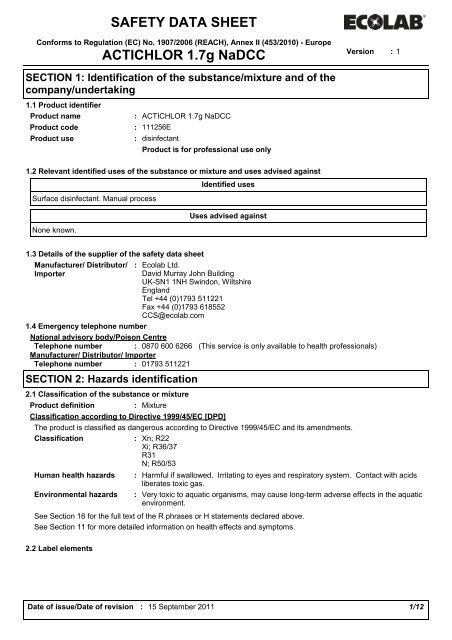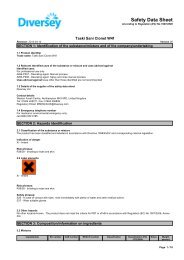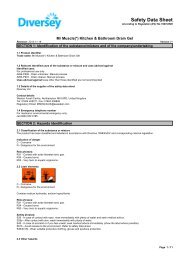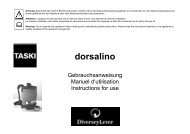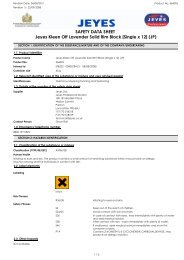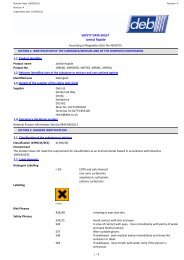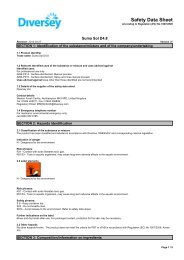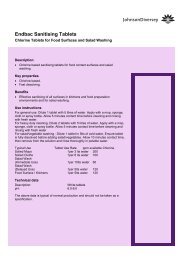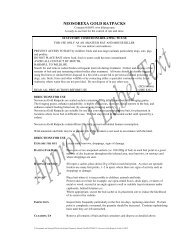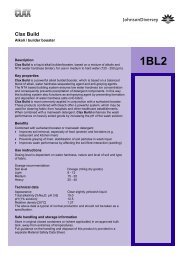SAFETY DATA SHEET ACTICHLOR 1.7g NaDCC - My Supply Chain
SAFETY DATA SHEET ACTICHLOR 1.7g NaDCC - My Supply Chain
SAFETY DATA SHEET ACTICHLOR 1.7g NaDCC - My Supply Chain
Create successful ePaper yourself
Turn your PDF publications into a flip-book with our unique Google optimized e-Paper software.
<strong>SAFETY</strong> <strong>DATA</strong> <strong>SHEET</strong><br />
Conforms to Regulation (EC) No. 1907/2006 (REACH), Annex II (453/2010) - Europe<br />
<strong>ACTICHLOR</strong> <strong>1.7g</strong> <strong>NaDCC</strong><br />
Version : 1<br />
SECTION 1: Identification of the substance/mixture and of the<br />
company/undertaking<br />
1.1 Product identifier<br />
Product name<br />
Product code :<br />
Product use<br />
:<br />
<strong>ACTICHLOR</strong> <strong>1.7g</strong> <strong>NaDCC</strong><br />
111256E<br />
: disinfectant<br />
Product is for professional use only<br />
1.2 Relevant identified uses of the substance or mixture and uses advised against<br />
Identified uses<br />
Surface disinfectant. Manual process<br />
Uses advised against<br />
None known.<br />
1.3 Details of the supplier of the safety data sheet<br />
Manufacturer/ Distributor/<br />
Importer<br />
:<br />
Ecolab Ltd.<br />
David Murray John Building<br />
UK-SN1 1NH Swindon, Wiltshire<br />
England<br />
Tel +44 (0)1793 511221<br />
Fax +44 (0)1793 618552<br />
CCS@ecolab.com<br />
1.4 Emergency telephone number<br />
National advisory body/Poison Centre<br />
Telephone number : 0870 600 6266 (This service is only available to health professionals)<br />
Manufacturer/ Distributor/ Importer<br />
Telephone number : 01793 511221<br />
SECTION 2: Hazards identification<br />
2.1 Classification of the substance or mixture<br />
Product definition<br />
The product is classified as dangerous according to Directive 1999/45/EC and its amendments.<br />
Classification<br />
: Xn; R22<br />
Xi; R36/37<br />
R31<br />
N; R50/53<br />
Human health hazards<br />
Environmental hazards<br />
: Mixture<br />
Classification according to Directive 1999/45/EC [DPD]<br />
:<br />
:<br />
Harmful if swallowed. Irritating to eyes and respiratory system. Contact with acids<br />
liberates toxic gas.<br />
Very toxic to aquatic organisms, may cause long-term adverse effects in the aquatic<br />
environment.<br />
See Section 16 for the full text of the R phrases or H statements declared above.<br />
See Section 11 for more detailed information on health effects and symptoms.<br />
2.2 Label elements<br />
Date of issue/Date of revision : 15 September 2011<br />
1/12
<strong>ACTICHLOR</strong> <strong>1.7g</strong> <strong>NaDCC</strong><br />
SECTION 2: Hazards identification<br />
Hazard symbol or symbols :<br />
Indication of danger :<br />
Contains<br />
:<br />
Risk phrases<br />
:<br />
Safety phrases<br />
:<br />
Harmful, Dangerous for the environment<br />
Troclosene sodium<br />
R22- Harmful if swallowed.<br />
R36/37- Irritating to eyes and respiratory system.<br />
R31- Contact with acids liberates toxic gas.<br />
R50/53- Very toxic to aquatic organisms, may cause long-term adverse effects in the<br />
aquatic environment.<br />
S2- Keep out of the reach of children.<br />
S8- Keep container dry.<br />
S26- In case of contact with eyes, rinse immediately with plenty of water and seek<br />
medical advice.<br />
S41- In case of fire and/or explosion do not breathe fumes.<br />
2.3 Other hazards<br />
Other hazards which do<br />
not result in classification<br />
:<br />
Not applicable.<br />
SECTION 3: Composition/information on ingredients<br />
3.2<br />
Mixtures<br />
Product/ingredient<br />
name<br />
Identifiers<br />
Troclosene sodium EC: 220-767-7<br />
CAS: 2893-78-9<br />
Index: 613-030-00-X<br />
Organic acids EC: 204-673-3<br />
CAS: 124-04-9<br />
Sodium<br />
Carbonate(soda)<br />
Index: 607-144-00-9<br />
REACH #: 01-<br />
2119485498-19<br />
EC: 207-838-8<br />
CAS: 497-19-8<br />
Index: 011-005-00-2<br />
Classification<br />
% 67/548/EEC Regulation (EC) No. Type<br />
1272/2008 [CLP]<br />
50-75 E; R2<br />
O; R8<br />
Xn; R22<br />
Xi; R36/37<br />
R31<br />
N; R50/53<br />
Ox. Sol. 2, H272<br />
Acute Tox. 4, H302<br />
Skin Irrit. 2, H315<br />
Eye Irrit. 2, H319<br />
STOT SE 3, H335<br />
Aquatic Acute 1, H400<br />
Aquatic Chronic 1, H410<br />
20-25 Xi; R36 Eye Irrit. 2, H319 [1]<br />
1-5 Xi; R36 Eye Irrit. 2, H319 [1]<br />
[1]<br />
See section 16 for<br />
the full text of the R-<br />
phrases declared<br />
above<br />
See Section 16 for the<br />
full text of the H<br />
statements declared<br />
above.<br />
There are no additional ingredients present which, within the current knowledge of the supplier and in the<br />
concentrations applicable, are classified as hazardous to health or the environment and hence require reporting in this<br />
section.<br />
Type<br />
Date of issue/Date of revision : 15 September 2011<br />
2/12
<strong>ACTICHLOR</strong> <strong>1.7g</strong> <strong>NaDCC</strong><br />
SECTION 3: Composition/information on ingredients<br />
[1] Substance classified with a health or environmental hazard<br />
[2] Substance with a workplace exposure limit<br />
[3] Substance meets the criteria for PBT according to Regulation (EC) No. 1907/2006, Annex XIII<br />
[4] Substance meets the criteria for vPvB according to Regulation (EC) No. 1907/2006, Annex XIII<br />
Occupational exposure limits, if available, are listed in Section 8.<br />
SECTION 4: First aid measures<br />
4.1 Description of first aid measures<br />
Eye contact<br />
: Immediately flush eyes with plenty of water, occasionally lifting the upper and lower<br />
eyelids. Check for and remove any contact lenses. Continue to rinse for at least 15<br />
minutes. Get medical attention if adverse health effects persist or are severe.<br />
Inhalation<br />
:<br />
Remove victim to fresh air and keep at rest in a position comfortable for breathing. If<br />
it is suspected that fumes are still present, the rescuer should wear an appropriate<br />
mask or self-contained breathing apparatus. If not breathing, if breathing is irregular<br />
or if respiratory arrest occurs, provide artificial respiration or oxygen by trained<br />
personnel. It may be dangerous to the person providing aid to give mouth-to-mouth<br />
resuscitation. Get medical attention if adverse health effects persist or are severe. If<br />
unconscious, place in recovery position and get medical attention immediately.<br />
Maintain an open airway. Loosen tight clothing such as a collar, tie, belt or<br />
waistband. In case of inhalation of decomposition products in a fire, symptoms may<br />
be delayed.<br />
Skin contact<br />
:<br />
Ingestion<br />
:<br />
Protection of first-aiders :<br />
Flush contaminated skin with plenty of water. Remove contaminated clothing and<br />
shoes. Get medical attention if symptoms occur. Wash clothing before reuse.<br />
Clean shoes thoroughly before reuse.<br />
Get medical attention immediately. Wash out mouth with water. Remove dentures if<br />
any. Remove victim to fresh air and keep at rest in a position comfortable for<br />
breathing. Do not induce vomiting unless directed to do so by medical personnel. If<br />
vomiting occurs, the head should be kept low so that vomit does not enter the lungs.<br />
Never give anything by mouth to an unconscious person. If unconscious, place in<br />
recovery position and get medical attention immediately. Maintain an open airway.<br />
Loosen tight clothing such as a collar, tie, belt or waistband.<br />
No action shall be taken involving any personal risk or without suitable training. It<br />
may be dangerous to the person providing aid to give mouth-to-mouth resuscitation.<br />
4.2 Most important symptoms and effects, both acute and delayed<br />
Potential acute health effects<br />
Eye contact<br />
:<br />
Inhalation<br />
Skin contact<br />
Ingestion<br />
Over-exposure signs/symptoms<br />
Eye contact<br />
Inhalation<br />
Skin contact<br />
Ingestion<br />
: Irritating to respiratory system. Exposure to decomposition products may cause a<br />
health hazard. Serious effects may be delayed following exposure.<br />
: No known significant effects or critical hazards.<br />
:<br />
Irritating to eyes.<br />
Harmful if swallowed.<br />
: Adverse symptoms may include the following:<br />
irritation<br />
watering<br />
redness<br />
:<br />
:<br />
:<br />
Adverse symptoms may include the following:<br />
respiratory tract irritation<br />
coughing<br />
No specific data.<br />
No specific data.<br />
4.3 Indication of any immediate medical attention and special treatment needed<br />
Notes to physician<br />
:<br />
In case of inhalation of decomposition products in a fire, symptoms may be delayed.<br />
Date of issue/Date of revision : 15 September 2011<br />
3/12
<strong>ACTICHLOR</strong> <strong>1.7g</strong> <strong>NaDCC</strong><br />
SECTION 4: First aid measures<br />
Specific treatments<br />
:<br />
No specific treatment.<br />
SECTION 5: Firefighting measures<br />
5.1 Extinguishing media<br />
Suitable extinguishing<br />
media<br />
Unsuitable extinguishing<br />
media<br />
:<br />
:<br />
In case of fire, use water spray (fog), foam, dry chemical or CO2.<br />
None known.<br />
5.2 Special hazards arising from the substance or mixture<br />
Hazards from the<br />
substance or mixture<br />
Hazardous combustion<br />
products<br />
:<br />
:<br />
No specific fire or explosion hazard.<br />
Decomposition products may include the following materials:<br />
carbon dioxide<br />
carbon monoxide<br />
nitrogen oxides<br />
halogenated compounds<br />
metal oxide/oxides<br />
5.3 Advice for firefighters<br />
Special precautions for<br />
fire-fighters<br />
Special protective<br />
equipment for fire-fighters<br />
:<br />
:<br />
Promptly isolate the scene by removing all persons from the vicinity of the incident if<br />
there is a fire. No action shall be taken involving any personal risk or without suitable<br />
training. This material is very toxic to aquatic organisms. Fire water contaminated<br />
with this material must be contained and prevented from being discharged to any<br />
waterway, sewer or drain.<br />
Fire-fighters should wear proper protective equipment.<br />
SECTION 6: Accidental release measures<br />
6.1 Personal precautions, protective equipment and emergency procedures<br />
For non-emergency<br />
personnel<br />
: No action shall be taken involving any personal risk or without suitable training.<br />
Evacuate surrounding areas. Keep unnecessary and unprotected personnel from<br />
entering. Do not touch or walk through spilt material. Provide adequate ventilation.<br />
Wear appropriate respirator when ventilation is inadequate. Put on appropriate<br />
personal protective equipment.<br />
For emergency responders :<br />
If specialised clothing is required to deal with the spillage, take note of any<br />
information in Section 8 on suitable and unsuitable materials. See also Section 8 for<br />
additional information on hygiene measures.<br />
6.2 Environmental<br />
precautions<br />
:<br />
Avoid dispersal of spilt material and runoff and contact with soil, waterways, drains<br />
and sewers. Inform the relevant authorities if the product has caused environmental<br />
pollution (sewers, waterways, soil or air). Water polluting material. May be harmful<br />
to the environment if released in large quantities.<br />
6.3 Methods and materials for containment and cleaning up<br />
Small spill: : Move containers from spill area. Vacuum or sweep up material and place in a<br />
designated, labelled waste container.<br />
Large spill :<br />
Prevent entry into sewers, water courses, basements or confined areas. Vacuum or<br />
sweep up material and place in a designated, labelled waste container.<br />
Date of issue/Date of revision : 15 September 2011<br />
4/12
<strong>ACTICHLOR</strong> <strong>1.7g</strong> <strong>NaDCC</strong><br />
SECTION 6: Accidental release measures<br />
6.4 Reference to other<br />
sections<br />
SECTION 7: Handling and storage<br />
:<br />
See Section 1 for emergency contact information.<br />
See Section 8 for information on appropriate personal protective equipment.<br />
See Section 13 for additional waste treatment information.<br />
The information in this section contains generic advice and guidance. The list of Identified Uses in Section 1 should be<br />
consulted for any available use-specific information provided in the Exposure Scenario(s).<br />
7.1 Precautions for safe handling<br />
Protective measures :<br />
Advice on general<br />
occupational hygiene<br />
:<br />
Put on appropriate personal protective equipment (see Section 8). Do not ingest.<br />
Avoid contact with eyes, skin and clothing. Avoid release to the environment. Refer<br />
to special instructions/safety data sheet. Use only with adequate ventilation. Wear<br />
appropriate respirator when ventilation is inadequate. Keep in the original container<br />
or an approved alternative made from a compatible material, kept tightly closed<br />
when not in use. Keep away from acids. Empty containers retain product residue<br />
and can be hazardous. Do not reuse container.<br />
Eating, drinking and smoking should be prohibited in areas where this material is<br />
handled, stored and processed. Workers should wash hands and face before<br />
eating, drinking and smoking. Remove contaminated clothing and protective<br />
equipment before entering eating areas. See also Section 8 for additional<br />
information on hygiene measures.<br />
7.2 Conditions for safe<br />
storage, including any<br />
incompatibilities<br />
:<br />
Store between the following temperatures: 0 to 25°C (32 to 77°F). Store in<br />
accordance with local regulations. Store in original container protected from direct<br />
sunlight in a dry, cool and well-ventilated area, away from incompatible materials<br />
(see section 10) and food and drink. Separate from acids. Keep container tightly<br />
closed and sealed until ready for use. Containers that have been opened must be<br />
carefully resealed and kept upright to prevent leakage. Do not store in unlabelled<br />
containers. Use appropriate containment to avoid environmental contamination.<br />
7.3 Specific end use(s)<br />
Recommendations :<br />
Industrial sector specific :<br />
solutions<br />
Not applicable.<br />
Not applicable.<br />
SECTION 8: Exposure controls/personal protection<br />
The information in this section contains generic advice and guidance. The list of Identified Uses in Section 1 should be<br />
consulted for any available use-specific information provided in the Exposure Scenario(s).<br />
8.1 Control parameters<br />
Occupational exposure limits<br />
Derived effect levels<br />
Product/ingredient name<br />
No exposure limit value known.<br />
No DNELs available.<br />
Predicted effect concentrations<br />
No PNECs available.<br />
Exposure limit values<br />
8.2 Exposure controls<br />
Date of issue/Date of revision : 15 September 2011<br />
5/12
<strong>ACTICHLOR</strong> <strong>1.7g</strong> <strong>NaDCC</strong><br />
SECTION 8: Exposure controls/personal protection<br />
Appropriate engineering<br />
controls<br />
Eye/face protection<br />
(EN 166)<br />
Skin protection<br />
Hand protection<br />
(EN 374)<br />
Respiratory protection<br />
(EN 143, 14387)<br />
Environmental exposure<br />
controls<br />
: Use only with adequate ventilation. If user operations generate dust, fumes, gas,<br />
vapour or mist, use process enclosures, local exhaust ventilation or other<br />
engineering controls to keep worker exposure to airborne contaminants below any<br />
recommended or statutory limits. Engineering controls may be required to control<br />
the primary or secondary risks associated with this product.<br />
Individual protection measures<br />
Hygiene measures : Wash hands, forearms and face thoroughly after handling chemical products, before<br />
eating, smoking and using the lavatory and at the end of the working period.<br />
Appropriate techniques should be used to remove potentially contaminated clothing.<br />
Wash contaminated clothing before reusing. Ensure that eyewash stations and<br />
safety showers are close to the workstation location.<br />
Body protection<br />
(EN 14605)<br />
Other skin protection<br />
Thermal hazards :<br />
:<br />
:<br />
:<br />
:<br />
:<br />
Safety glasses.<br />
No special recommendations.<br />
Personal protective equipment for the body should be selected based on the task<br />
being performed and the risks involved and should be approved by a specialist<br />
before handling this product.<br />
Appropriate footwear and any additional skin protection measures should be<br />
selected based on the task being performed and the risks involved and should be<br />
approved by a specialist before handling this product.<br />
A respirator is not needed under normal and intended conditions of product use.<br />
Not applicable.<br />
: Emissions from ventilation or work process equipment should be checked to ensure<br />
they comply with the requirements of environmental protection legislation. In some<br />
cases, fume scrubbers, filters or engineering modifications to the process<br />
equipment will be necessary to reduce emissions to acceptable levels.<br />
SECTION 9: Physical and chemical properties<br />
9.1 Information on basic physical and chemical properties<br />
Appearance<br />
Physical state<br />
Colour<br />
Odour<br />
Odour threshold<br />
pH<br />
Melting point/freezing point<br />
Initial boiling point and boiling<br />
range<br />
Evaporation rate<br />
Upper/lower flammability or<br />
explosive limits<br />
Vapour pressure<br />
Vapour density<br />
Solid<br />
White<br />
chlorine<br />
Flash point : > 100°C<br />
Flammability (solid, gas)<br />
Burning time<br />
Burning rate<br />
:<br />
:<br />
:<br />
: Not applicable and/or not determined for the mixture.<br />
: 4.5 to 7.5 [Conc. (% w/w): 1%]<br />
: Not applicable and/or not determined for the mixture.<br />
: Not applicable and/or not determined for the mixture.<br />
:<br />
: Not applicable and/or not determined for the mixture.<br />
: Not applicable and/or not determined for the mixture.<br />
:<br />
:<br />
:<br />
Not applicable and/or not determined for the mixture.<br />
Not applicable and/or not determined for the mixture.<br />
: Not applicable and/or not determined for the mixture.<br />
Not applicable and/or not determined for the mixture.<br />
Not applicable and/or not determined for the mixture.<br />
Relative density<br />
:<br />
Not applicable and/or not determined for the mixture.<br />
Date of issue/Date of revision : 15 September 2011<br />
6/12
<strong>ACTICHLOR</strong> <strong>1.7g</strong> <strong>NaDCC</strong><br />
SECTION 9: Physical and chemical properties<br />
Solubility(ies)<br />
Partition coefficient: n-<br />
octanol/water<br />
Auto-ignition temperature<br />
Decomposition temperature :<br />
Viscosity :<br />
Explosive properties<br />
Oxidising properties :<br />
:<br />
:<br />
:<br />
:<br />
Easily soluble in the following materials: cold water.<br />
Not applicable and/or not determined for the mixture.<br />
Not applicable and/or not determined for the mixture.<br />
Not applicable and/or not determined for the mixture.<br />
Not applicable and/or not determined for the mixture.<br />
Not applicable.<br />
Yes.<br />
9.2 Other information<br />
No additional information.<br />
SECTION 10: Stability and reactivity<br />
10.1 Reactivity : No specific test data related to reactivity available for this product or its ingredients.<br />
10.2 Chemical stability :<br />
The product is stable.<br />
10.3 Possibility of<br />
hazardous reactions<br />
: Hazardous reactions or instability may occur under certain conditions of storage or<br />
use.<br />
Conditions may include the following:<br />
contact with acids<br />
Reactions may include the following:<br />
liberation of toxic gas<br />
10.4 Conditions to avoid : No specific data.<br />
10.5 Incompatible materials :<br />
Extremely reactive or incompatible with the following materials: acids.<br />
10.6 Hazardous<br />
decomposition products<br />
Acute toxicity<br />
:<br />
Contact with acids liberates toxic gas.<br />
SECTION 11: Toxicological information<br />
11.1 Information on toxicological effects<br />
Product/ingredient name Result Species Dose Exposure<br />
Troclosene sodium LD50 Dermal Rabbit >2000 mg/kg -<br />
LD50 Oral Mammal 1670 mg/kg -<br />
LD50 Oral Rat 1420 mg/kg -<br />
Organic acids LD50 Dermal Rabbit >7940 mg/kg -<br />
LD50 Oral Rat 5050 mg/kg -<br />
Sodium Carbonate(soda) LD50 Dermal Rabbit >2000 mg/kg -<br />
LD50 Oral Rat 4090 mg/kg -<br />
Conclusion/Summary<br />
Irritation/Corrosion<br />
: No known significant effects or critical hazards.<br />
Product/ingredient name Result Species Score Exposure Observation<br />
Date of issue/Date of revision : 15 September 2011<br />
7/12
<strong>ACTICHLOR</strong> <strong>1.7g</strong> <strong>NaDCC</strong><br />
SECTION 11: Toxicological information<br />
Troclosene sodium Eyes - Mild irritant Rabbit - 24 hours 100 -<br />
milligrams<br />
Eyes - Moderate irritant Rabbit - 24 hours 10 -<br />
milligrams<br />
Skin - Mild irritant Rabbit - 24 hours 500 -<br />
milligrams<br />
Skin - Severe irritant Rabbit - 500<br />
-<br />
milligrams<br />
Eyes - Severe irritant Rabbit - 0.1 Grams -<br />
Organic acids Eyes - Mild irritant Rabbit - 10 milligrams -<br />
Eyes - Moderate irritant Rabbit - 24 hours 20 -<br />
milligrams<br />
Skin - Mild irritant Rabbit - 0.25 Grams -<br />
Sodium Carbonate(soda) Eyes - Mild irritant Rabbit - 0.5 minutes -<br />
100<br />
milligrams<br />
Eyes - Moderate irritant Rabbit - 24 hours 100 -<br />
milligrams<br />
Eyes - Severe irritant Rabbit - 50 milligrams -<br />
Skin - Mild irritant Rabbit - 24 hours 500<br />
milligrams<br />
-<br />
Conclusion/Summary<br />
Sensitiser<br />
Conclusion/Summary<br />
Mutagenicity<br />
Conclusion/Summary<br />
Carcinogenicity<br />
Conclusion/Summary<br />
Reproductive toxicity<br />
Conclusion/Summary<br />
Teratogenicity<br />
Conclusion/Summary : No known significant effects or critical hazards.<br />
Information on the likely : No known significant effects or critical hazards.<br />
routes of exposure<br />
Potential acute health effects<br />
Inhalation<br />
: Irritating to respiratory system. Exposure to decomposition products may cause a<br />
health hazard. Serious effects may be delayed following exposure.<br />
Ingestion<br />
Skin contact<br />
Eye contact<br />
: Harmful if swallowed.<br />
: No known significant effects or critical hazards.<br />
:<br />
Irritating to eyes.<br />
Symptoms related to the physical, chemical and toxicological characteristics<br />
Inhalation<br />
Ingestion<br />
Skin contact<br />
Eye contact<br />
: No known significant effects or critical hazards.<br />
: No known significant effects or critical hazards.<br />
:<br />
:<br />
:<br />
Adverse symptoms may include the following:<br />
respiratory tract irritation<br />
coughing<br />
No specific data.<br />
No specific data.<br />
: Adverse symptoms may include the following:<br />
irritation<br />
watering<br />
redness<br />
Delayed and immediate effects and also chronic effects from short and long term exposure<br />
Short term exposure<br />
: No known significant effects or critical hazards.<br />
: No known significant effects or critical hazards.<br />
: No known significant effects or critical hazards.<br />
Date of issue/Date of revision : 15 September 2011<br />
8/12
<strong>ACTICHLOR</strong> <strong>1.7g</strong> <strong>NaDCC</strong><br />
SECTION 11: Toxicological information<br />
Potential immediate<br />
effects<br />
Potential delayed effects :<br />
Long term exposure<br />
Potential immediate : No known significant effects or critical hazards.<br />
effects<br />
Potential delayed effects : No known significant effects or critical hazards.<br />
Potential chronic health effects<br />
Conclusion/Summary<br />
General :<br />
Carcinogenicity :<br />
Mutagenicity :<br />
Teratogenicity :<br />
Developmental effects<br />
Fertility effects<br />
Other information<br />
SECTION 12: Ecological information<br />
12.1 Toxicity<br />
Product/ingredient name<br />
:<br />
No known significant effects or critical hazards.<br />
No known significant effects or critical hazards.<br />
: No known significant effects or critical hazards.<br />
No known significant effects or critical hazards.<br />
No known significant effects or critical hazards.<br />
No known significant effects or critical hazards.<br />
No known significant effects or critical hazards.<br />
: No known significant effects or critical hazards.<br />
: No known significant effects or critical hazards.<br />
: No known significant effects or critical hazards.<br />
Troclosene sodium Acute EC50 0.11 mg/L Daphnia 48 hours<br />
Acute LC50 0.217 mg/L Fish 96 hours<br />
Organic acids Acute LC50 97000 ug/L Fresh water Fish - Pimephales promelas - 96 hours<br />
Juvenile (Fledgling, Hatchling,<br />
Weanling) - 4 to 8 weeks - 1.1 to<br />
3.1 cm<br />
Sodium Carbonate(soda) Acute EC50 199.82 to 298.9 mg/L Daphnia - Neonate - 24 hours 48 hours<br />
Fresh water<br />
Acute LC50 300 mg/l Fish 96 hours<br />
Conclusion/Summary<br />
Result<br />
Species<br />
: No known significant effects or critical hazards.<br />
Exposure<br />
12.2 Persistence and degradability<br />
Conclusion/Summary<br />
: The ecological evaluation of the product is based on data from the raw material<br />
and/or comparable substances. The product contains active chlorine or active<br />
chlorine carriers. Officially determined threshold values for wastewater (also for<br />
partial flows, if applicable) and local discharge guidelines must be observed. Due to<br />
its application field the product is not subject to the European Detergent Regulation<br />
(EC/648/2004).<br />
12.3 Bioaccumulative potential<br />
Conclusion/Summary<br />
: Not determined for the mixture.<br />
12.4 Mobility in soil<br />
Soil/water partition<br />
coefficient (KOC)<br />
Mobility<br />
: Not determined for the mixture.<br />
: Not determined for the mixture.<br />
12.5 Results of PBT and vPvB assessment<br />
PBT<br />
vPvB<br />
: Not applicable.<br />
: Not applicable.<br />
Date of issue/Date of revision : 15 September 2011<br />
9/12
<strong>ACTICHLOR</strong> <strong>1.7g</strong> <strong>NaDCC</strong><br />
SECTION 12: Ecological information<br />
12.6 Other adverse effects : No known significant effects or critical hazards.<br />
SECTION 13: Disposal considerations<br />
The information in this section contains generic advice and guidance. The list of Identified Uses in Section 1 should be<br />
consulted for any available use-specific information provided in the Exposure Scenario(s).<br />
13.1 Waste treatment methods<br />
Product<br />
Methods of disposal :<br />
The generation of waste should be avoided or minimised wherever possible. Empty<br />
containers or liners may retain some product residues. This material and its<br />
container must be disposed of in a safe way. Significant quantities of waste product<br />
residues should not be disposed of via the foul sewer but processed in a suitable<br />
effluent treatment plant. Dispose of surplus and non-recyclable products via a<br />
licensed waste disposal contractor. Disposal of this product, solutions and any byproducts<br />
should at all times comply with the requirements of environmental<br />
protection and waste disposal legislation and any regional local authority<br />
requirements. Avoid dispersal of spilt material and runoff and contact with soil,<br />
waterways, drains and sewers.<br />
Hazardous waste : Yes.<br />
European waste catalogue (EWC)<br />
Waste code<br />
Waste designation<br />
20 01 29* detergents containing dangerous substances<br />
Packaging<br />
Methods of disposal :<br />
Special precautions :<br />
The generation of waste should be avoided or minimised wherever possible. Waste<br />
packaging should be recycled.<br />
This material and its container must be disposed of in a safe way. Care should be<br />
taken when handling emptied containers that have not been cleaned or rinsed out.<br />
Empty containers or liners may retain some product residues. Avoid dispersal of<br />
spilt material and runoff and contact with soil, waterways, drains and sewers.<br />
SECTION 14: Transport information<br />
ADR/RID ADN/ADNR<br />
IMDG IATA<br />
14.1 UN number<br />
UN3077<br />
UN3077<br />
UN3077<br />
UN3077<br />
14.2 UN proper<br />
shipping name<br />
ENVIRONMENTALLY<br />
HAZARDOUS<br />
SUBSTANCE, SOLID,<br />
N.O.S. (Troclosene<br />
sodium)<br />
ENVIRONMENTALLY<br />
HAZARDOUS<br />
SUBSTANCE, SOLID,<br />
N.O.S. (Troclosene<br />
sodium)<br />
ENVIRONMENTALLY<br />
HAZARDOUS<br />
SUBSTANCE, SOLID,<br />
N.O.S. (Troclosene<br />
sodium). Marine<br />
pollutant<br />
Environmentally<br />
hazardous substance,<br />
solid, n.o.s.<br />
(Troclosene sodium)<br />
14.3 Transport<br />
hazard class(es)<br />
9<br />
9<br />
9<br />
9<br />
14.4 Packing<br />
group<br />
III<br />
III<br />
III<br />
III<br />
14.5<br />
Environmental<br />
hazards<br />
Yes. Yes. Yes. Yes.<br />
Date of issue/Date of revision : 15 September 2011<br />
10/12
<strong>ACTICHLOR</strong> <strong>1.7g</strong> <strong>NaDCC</strong><br />
SECTION 14: Transport information<br />
14.6 Special<br />
precautions for<br />
user<br />
None. None. None. None.<br />
14.7 Transport in bulk<br />
according to Annex II of<br />
MARPOL 73/78 and the IBC<br />
Code<br />
: Not applicable.<br />
SECTION 15: Regulatory information<br />
15.1 Safety, health and environmental regulations/legislation specific for the substance or mixture<br />
EU Regulation (EC) No. 1907/2006 (REACH)<br />
Annex XIV - List of substances subject to authorisation<br />
Substances of very high concern<br />
None of the components are listed.<br />
Annex XVII - Restrictions<br />
on the manufacture,<br />
placing on the market and<br />
use of certain dangerous<br />
substances, mixtures and<br />
articles<br />
: Not applicable.<br />
Other EU regulations<br />
National regulations<br />
United Kingdom (UK)<br />
The Chemicals (Hazard Information and Packaging for <strong>Supply</strong>) Regulations.<br />
The Control of Substances Hazardous to Health Regulations.<br />
Health and Safety at Work Act.<br />
15.2 Chemical Safety<br />
Assessment<br />
:<br />
This product contains substances for which Chemical Safety Assessments are still<br />
required.<br />
SECTION 16: Other information<br />
Indicates information that has changed from previously issued version.<br />
Abbreviations and<br />
acronyms<br />
: ADR = The European Agreement concerning the International Carriage of<br />
Dangerous Goods by Road<br />
ATE = Acute Toxicity Estimate<br />
BCF = Bioconcentration Factor<br />
CLP = Classification, Labelling and Packaging Regulation [Regulation (EC) No.<br />
1272/2008]<br />
DNEL = Derived No Effect Level<br />
EUH statement = CLP-specific Hazard statement<br />
IATA = International Air Transport Association<br />
IBC = Intermediate Bulk Container<br />
IMDG = International Maritime Dangerous Goods<br />
LogPow = logarithm of the octanol/water partition coefficient<br />
MARPOL 73/78 = International Convention for the Prevention of Pollution From<br />
Ships, 1973 as modified by the Protocol of 1978. ("Marpol" = marine pollution)<br />
PNEC = Predicted No Effect Concentration<br />
RID = The Regulations concerning the International Carriage of Dangerous Goods<br />
by Rail<br />
REACH# = REACH Registration Number<br />
Date of issue/Date of revision : 15 September 2011<br />
11/12
<strong>ACTICHLOR</strong> <strong>1.7g</strong> <strong>NaDCC</strong><br />
SECTION 16: Other information<br />
Full text of abbreviated H<br />
statements<br />
Full text of classifications<br />
[CLP/GHS]<br />
Full text of abbreviated R<br />
phrases<br />
Full text of classifications<br />
[DSD/DPD]<br />
Date of printing<br />
Date of issue/ Date of<br />
revision<br />
Date of previous issue<br />
Version<br />
Notice to reader<br />
:<br />
:<br />
:<br />
:<br />
:<br />
:<br />
:<br />
:<br />
H272 May intensify fire; oxidiser.<br />
H302 Harmful if swallowed.<br />
H315 Causes skin irritation.<br />
H319 Causes serious eye irritation.<br />
H335 May cause respiratory irritation.<br />
H400 Very toxic to aquatic life.<br />
H410 Very toxic to aquatic life with long lasting effects.<br />
Acute Tox. 4, H302 ACUTE TOXICITY: ORAL - Category 4<br />
Aquatic Acute 1, H400 AQUATIC TOXICITY (ACUTE) - Category 1<br />
Aquatic Chronic 1, H410 AQUATIC TOXICITY (CHRONIC) - Category 1<br />
Eye Irrit. 2, H319 SERIOUS EYE DAMAGE/ EYE IRRITATION - Category 2<br />
Ox. Sol. 2, H272 OXIDIZING SOLIDS - Category 2<br />
Skin Irrit. 2, H315 SKIN CORROSION/IRRITATION - Category 2<br />
STOT SE 3, H335 SPECIFIC TARGET ORGAN TOXICITY (SINGLE<br />
EXPOSURE) [Respiratory tract irritation] - Category 3<br />
R2- Risk of explosion by shock, friction, fire or other sources of ignition.<br />
R8- Contact with combustible material may cause fire.<br />
R22- Harmful if swallowed.<br />
R36- Irritating to eyes.<br />
R36/37- Irritating to eyes and respiratory system.<br />
R31- Contact with acids liberates toxic gas.<br />
R50/53- Very toxic to aquatic organisms, may cause long-term adverse effects in the<br />
aquatic environment.<br />
E - Explosive<br />
O - Oxidising<br />
Xn - Harmful<br />
Xi - Irritant<br />
N - Dangerous for the environment<br />
9/15/2011.<br />
9/15/2011.<br />
No previous validation.<br />
1<br />
The above information is believed to be correct with respect to the formula used to manufacture the product in<br />
the country of origin. As data, standards, and regulations change, and conditions of use and handling are<br />
beyond our control, NO WARRANTY, EXPRESS OR IMPLIED, IS MADE AS TO THE COMPLETENESS OR<br />
CONTINUING ACCURACY OF THIS INFORMATION.<br />
Date of issue/Date of revision : 15 September 2011<br />
12/12


